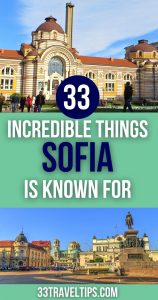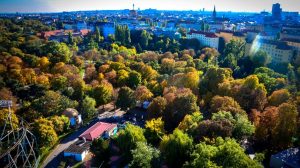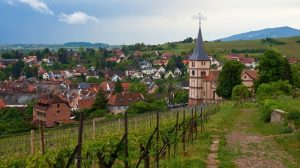
Sofia is known for the Alexander Nevsky Cathedral, its hot mineral springs, ancient Roman history, and countless museums. The Bulgarian capital is also famous for its lush parks, Viennese-style architecture, unusual bridges, and the jaw-dropping Vitosha Mountain.
In this guide, you’ll find 33 amazing things Sofia is famous for.
From centuries-old churches to royal gardens, and from Roman pathways to fascinating museums, we bet you’ll discover what is Sofia, Bulgaria, known for.
Buckle up and let’s explore!
✅ Note: This article contains affiliate links. In case you purchase something through one of these links, we may receive a small commission at no extra cost to you. Thank you for helping us keep creating the free content on this website!
The Landmarks Sofia Is Famous For
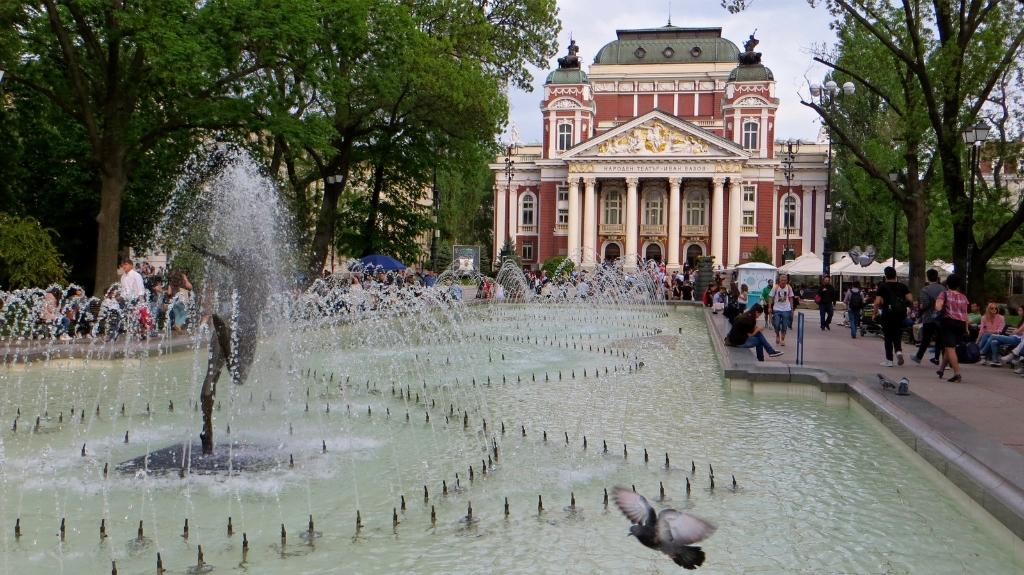
Animal-adorned bridges, mineral springs, and Roman ruins are just a few of the attractions that make Sofia special. Let’s explore them below:
- The hot mineral springs. Sofia is one of the very few capital cities in the world that has hot mineral springs within its city limits. The best part about the springs? You can find them at various locations throughout the city. The most famous ones are next to the Sofia Central Mineral Baths near Marie Louise Boulevard. The hot water is great for both quenching your thirst and for alleviating various illnesses, including an upset stomach.
- Eagles’ Bridge. Sofia prides itself on two famous bridges. The more popular is the Eagles’ Bridge (Orlov Most). As the name suggests, several eagles adorn the bridge. It used to be one of the two symbolic entries into the old city. The eagle figures on the bridge’s four ends allegorize the longing for freedom.
- Lions’ Bridge. The second “animal” bridge in Sofia is the Lions’ Bridge. It acts as an important junction between two major boulevards – Marie Louise and Slivnitsa. The Lions’ Bridge connects the Central Railway Station with Sofia’s center and marks the city’s northern border. Four massive bronze lion sculptures decorate the bridge on each of its sides.
- Ivan Vazov National Theater. Svet’s favorite building in Sofia is the Ivan Vazov National Theater. And for a good reason. Besides being one of the city’s most important landmarks, its façade faces the City Garden. Ferdinand Fellner and Hermann Helmer, two famous Viennese theater architects, designed the Neoclassical building of the theater. In front, you’ll find a big square and a breathtaking fountain.
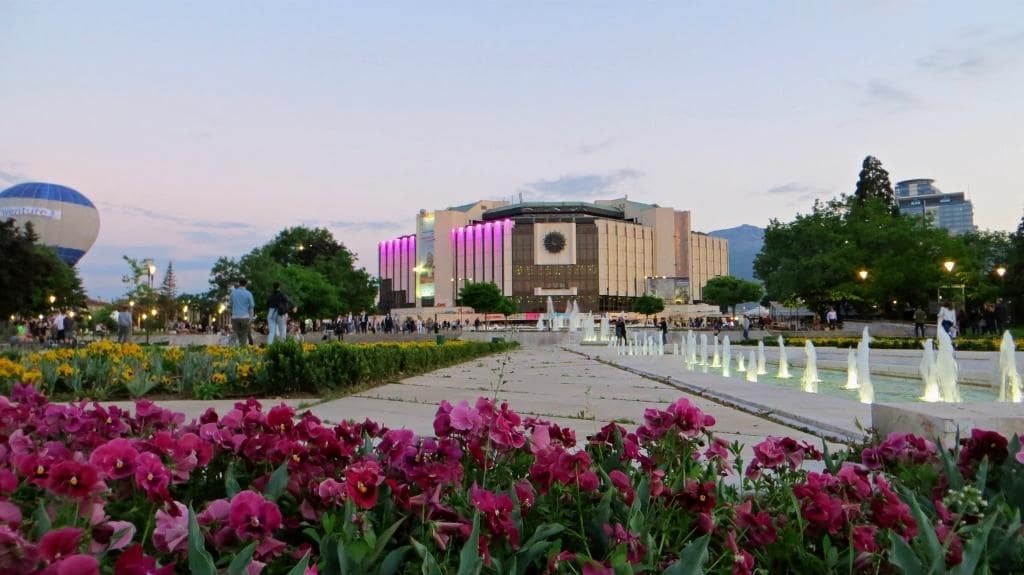
- Vitosha Boulevard. Fifth Avenue is to Manhattan as is Vitosha Boulevard to Sofia. The city’s main thoroughfare has a pedestrian area and stretches all the way to the South Park. On the boulevard, you’ll find hundreds of stores and high-end boutiques, selling everything from shoes and clothes to jewelry and cosmetics. If you’re wondering where to stay in Sofia, and you don’t mind splurging, we recommend the Les Fleurs Boutique Hotel on Vitosha Boulevard.
- Ancient Roman ruins. Modern Sofia sits on the remnants of the old city of Serdica. You can stumble upon Roman ruins almost everywhere in the city center. The Serdica Amphitheater was among the largest in the eastern part of the Roman Empire. An interesting Sofia fact is that the 5-star Arena di Serdica Boutique Hotel hosts the remains of the amphitheater.
- St. Sofia Monument. The imposing St. Sofia Monument overlooks Sofia’s downtown. Built in 2000, the 26-ft. (8-m) bronze statue is one of the symbols of Bulgaria’s capital. St. Sofia wears three important symbols – a crown (power), a wreath (fame), and an owl (wisdom). When you visit the monument, notice the yellow-cobblestoned road that leads from the monument. It stretches past many of Sofia’s attractions. The yellow stones are iconic for the Bulgarian capital.
- National Palace of Culture. This gigantic building is the biggest multifunctional conference and exhibition center not only in Bulgaria but in southeastern Europe. The National Palace of Culture (NDK) opened its door in 1981 to celebrate the 1,300th anniversary of Bulgaria. Around the building, you’ll find numerous green spaces, gardens, and a chain of fountains. NDK has 13 halls and 161,460 sq. ft. (15,000 sq. m) of exhibition area spread over eight floors and three underground levels.
The Religious Temples Sofia Is Known For
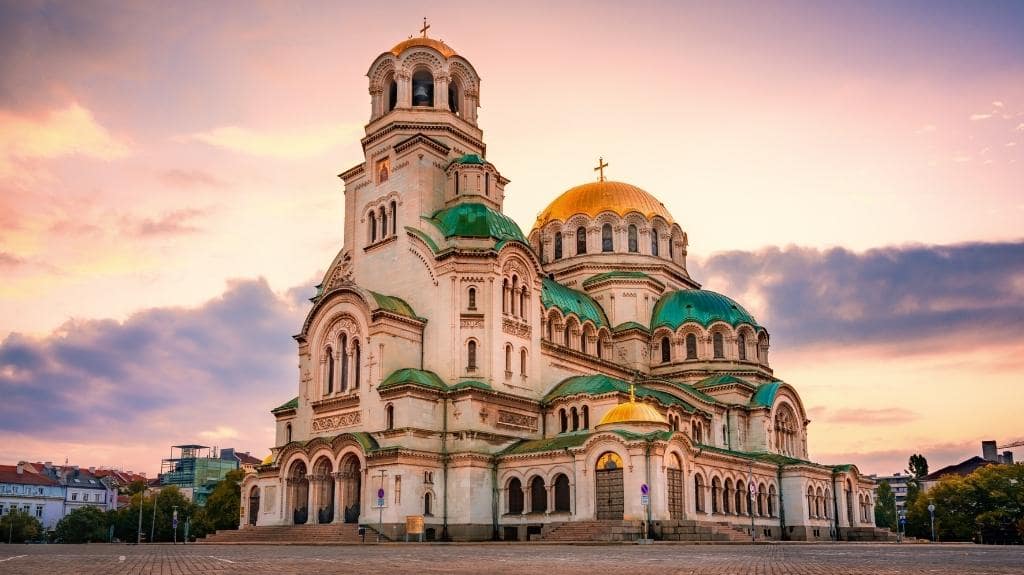
One of the best reasons Sofia is worth visiting is to explore its rich history through the religious sites of the Bulgarian capital. In this section, you’ll find the temples Sofia is famous for.
- St. George’s Rotunda. The city’s oldest church, and one of the oldest in Europe, sits quietly between the Presidency, the Ministry of Education, and Sofia Hotel Balkan. The brick building of St. George’s Rotunda dates back to the 4th century. Around the Rotunda, you can wander the remnants of a Roman street and residential buildings.
- Alexander Nevsky Cathedral. The largest cathedral in Bulgaria, and one of the largest Orthodox cathedrals worldwide, is fairly new. It was erected in the New-Byzantine style in 1912. The temple is the most famous attraction Sofia, Bulgaria is known for. The exterior strikes you with its staggering golden domes visible from an airplane. Inside, you’ll admire breathtaking thrones and marble columns of various colors. Don’t miss Alexander Nevsky’s Crypt Museum located below the cathedral.
- St. Sofia Church. This red-bricked Byzantine temple is right next to Alexander Nevsky. The 6th-century church offers a gigantic chamber. Despite its old age, below the St. Sofia Church, you’ll find one of the newest Sofia museums, which opened its doors in 2013. Inside, you can explore a necropolis, containing more than 50 tombs built between the 3rd and 5th centuries BC.
- Boyana Church. The 10th-century Boyana Church was added to the UNESCO World Heritage List in 1979. Compared to most churches in Sofia, the one in Boyana is minuscule. That’s why visits are timed and limited to small groups of 8-10 people. When inside, marvel at the stunning frescoes that date to the 11th and 12th centuries. Tip: Entrance is free of charge every Monday after 3:00 PM. If you can’t visit then, buy a combined ticket for both the Boyana Church and the National History Museum.

- The Sofia Synagogue. The Austrian architect Grunanger planned The Sofia Synagogue in Bulgarian National Romanticism style in the early 1900s. One of the most interesting facts about Sofia is that the synagogue is the largest Sephardic synagogue in Europe, and the second-largest synagogue on the continent after the Dohány Street Synagogue in Budapest.
- Banya Bashi Mosque. The central mosque in Sofia used to be a part of a big bath complex. That’s why its name includes the word “banya”, which means bath. The great Kodja Mimar Sinan who designed the most popular mosques in the Ottoman Empire also designed Banya Bashi Mosque. Inside, you’ll find floral ornaments and artistically inscribed Quran citations.
- Church of St. Nicholas, the Miracle-Maker. Also known as the Russian Church, this religious temple is among Sofia’s most gorgeously decorated. Both the interior and exterior of St. Nicholas Church boast rich details, as well as gold, marble, and colorful tiles. The church’s distinguishable onion golden domes are a great juxtaposition to the surrounding buildings in the city center.
- Kremikovtsi Monastery. Just 2 mi (3 km) away from Sofia’s Kremikovtsi neighborhood, you’ll discover one of Bulgaria’s numerous monasteries. The Kremikovtsi Monastery of St. George the Victorious was founded during the Second Bulgarian Empire in the 12th century. Then, a local Bulgarian noble re-established it in 1493. The monastery boasts not one but two churches. The medieval one is worth visiting for its mind-blowing 15th-century frescoes.
The Most Popular Museums in Sofia
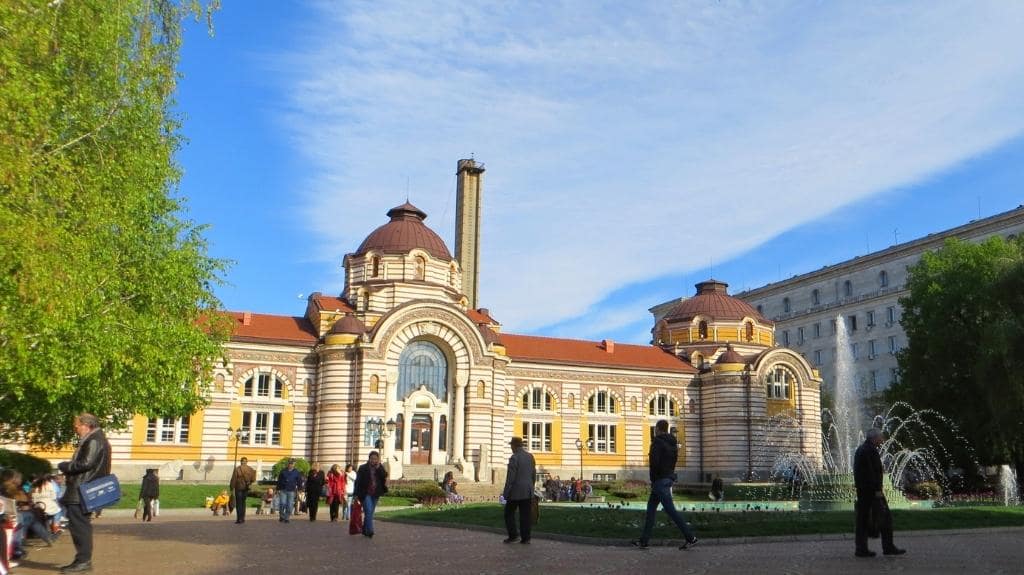
The Bulgarian capital packs a powerful punch of peculiar museums. From geological to historical, and from polytechnic to military, let’s discover the museums Sofia is known for.
- Sofia Central Mineral Baths. The Central Mineral Baths served as Sofia’s public baths until 1986. The building’s design epitomizes the Vienna Secession style with Bulgarian, Byzantine, and Eastern Orthodox elements. Since 2015, the bathhouse has been hosting the Regional History Museum Sofia, which narrates the Bulgarian capital’s rich history. On both sides of the entrance, you can find mineral water drinking fountains.
- National Historical Museum. Sofia prides itself on Bulgaria’s largest museum – the National Historical Museum (NHM). Nowadays, the museum contains more than 650,000 objects that cover fine arts, history, archaeology, and ethnography. The major excavated exhibits include several Ancient Thracian treasures, including the opulent Valchitran Treasure and the Panagyurishte Treasure. Tip: The regular museum ticket price is 10.00 BGN ($5.10), but we suggest you purchase a combined ticket for 12.00 BGN ($6.15). It includes entrances to both the NHM and the UNESCO-listed Boyana Church.
- Earth and Man National Museum. Close to the National Palace of Culture, you’ll discover the Earth and Man National Museum. Opened to the public in 1987, it’s one of the largest mineralogical museums worldwide. Earth and Man’s collection covers over 40% of all known naturally occurring minerals, including gigantic quartz, tourmaline, and amethyst stones.
- National Museum of Natural History. Affiliated with the Bulgarian Academy of Sciences, the National Museum of Natural History exhibits nearly 1.5 million specimens of animals, plants, and minerals. That makes it the richest natural history museum on the Balkans. Inside, you’ll have a chance to explore 15 halls on 4 floors. Don’t miss seeing the monk seal, German sturgeon, steppe viper, and the Caroline parrot, which became extinct worldwide.
- National Archaeological Museum. One of the most interesting facts about Sofia is that the National Archaeological Museum occupies the building of the oldest and largest former Ottoman mosque – Koca Mahmut Paşa Camii. The museum’s inauguration happened in 1905. Today, the National Archaeological Museum consists of five exhibition halls – Prehistory, Middle Ages, Treasure, Central, and a special temporary exhibition.

- National Museum of Military History. This gigantic exposition space covers 53,820 sq. ft. (5,000 sq. m) of indoor and 430,555 sq. ft. (40,000 sq. m.) of outdoor exhibition areas. On the territory of the National Museum of Military History, you can discover tanks, missiles, aircraft, artillery, and military vehicles. Peculiarly, it became the 3rd national museum institution in Bulgaria, dating back to 1906.
- National Art Gallery. Inside Bulgaria’s national gallery, you can marvel at 50,000 pieces of Bulgarian art. The National Art Gallery also houses the country’s biggest collection of medieval paintings, including over 4,000 icons. The gallery displays its numerous art pieces in a drop-dead beautiful royal palace that incorporates Viennese Neo-Baroque elements. Even if you don’t want to go inside, make sure to check the building’s exterior.
- National Polytechnic Museum. Although the museum boasts a whopping collection of more than 22,000 items, only 1,000 of them are on permanent display. The National Polytechnic Museum has divided its collections into exhibitions that showcase transportation, photography and cinema, time measurement, radio and television, optics, computing equipment, and others. Don’t miss the space food and instruments for space satellites.
- Museum of Socialist Art. Established in 2011, the Museum of Socialist Art is among the most peculiar Sofia museums. As the name suggests, it walks you around the history of Bulgaria’s communist era. Sculptures and paintings represent the period from 1944 to 1989. A staggering five-pointed star guards the museum’s entrance. In the statue park, you’ll find busts, statues, and figures of popular communist leaders, as well as sculptures of red army soldiers, agricultural, and industrial workers.
- Museum of Illusions Sofia. It might be one of the newest museums in Sofia, but the Museum of Illusions will blow your mind in tiny pieces. More than 4,300 sq. ft. (400 sq. m) of riveting illusions and wonderful atmosphere await you inside this contemporary exhibition hall. The museum’s team is constantly enriching its collection by adding several new exhibits every year. Since the museum is almost always busy, we recommend grabbing your ticket in advance via this link.
- Muzeiko. If you’re traveling to Sofia with kids, you shouldn’t miss this children’s museum. Muzeiko models kids’ museums in the U.S. by taking into consideration the learning process in children of different ages. The building generates its own electricity, heats itself with geothermal energy, and collects rainwater. Entrance tickets give you access to 3 floors, 13 exhibitions, and over 130 interactive games.
The Gorgeous Parks and Mountains Sofia Is Famous For
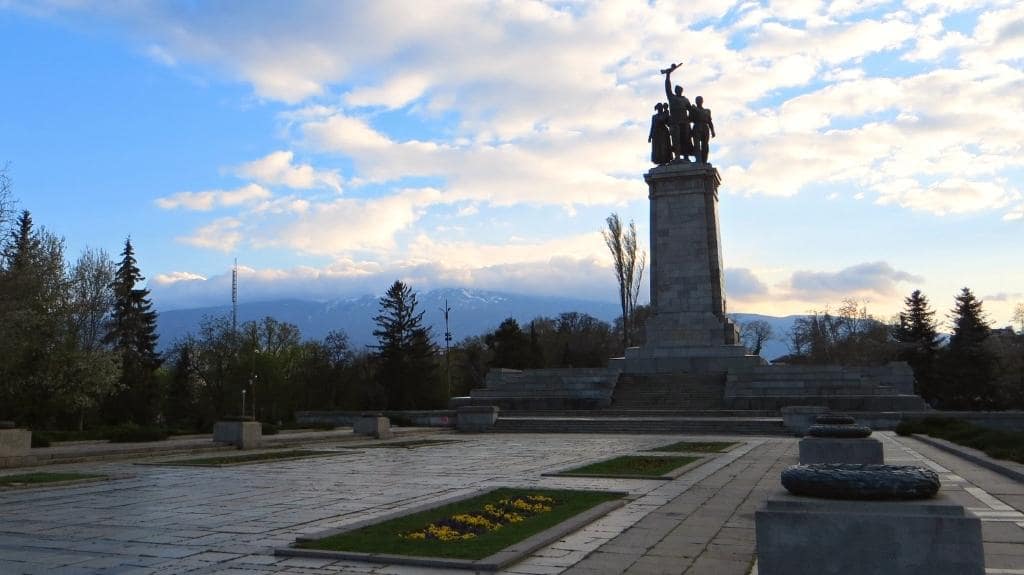
Much like London, which is designated as a forest, Sofia teems with verdant parks. But the Bulgarian capital beats the capital of the U.K. because it’s also surrounded by dozens of mountains. Let’s explore the parks and mountains Sofia is known for below:
- Borisova Gradina Park. Literally meaning “Boris’s Garden”, Borisova Gradina carries the name of one of Bulgaria’s most famous modern kings – Boris. As Sofia’s oldest and most popular park, it attracts throngs of visitors every day. The garden teems with centuries-old trees, imposing monuments, sports arenas, and several lakes and ponds. Get lost in Borisova Gradina’s miles of tree-lined paths, or simply sit on a bench and people-watch.
- Park Vrana. An impressive work of landscape garden art, Park Vrana dates back to the first half of the 20th century. It used to be part of the royal estate of the Bulgarian Kings Ferdinand I and Boris III. The son of Boris III, Simeon Saxe-Coburg-Gotha, gifted the park to the Sofia municipality. Park Vrana is 7 mi (11 km) away from the city center on the outskirts of the city. Note that the garden is open to the public only on weekends and during official holidays.
- South Park. Next in popularity after Borisova Gradina is South Park. Just 15 minutes on foot from the National Palace of Culture and the city center, the park is a wonderful getaway for locals and tourists alike. Like running? South Park in Sofia is one of the hosts of an event called “The 5-km Run” (approximately 3.1 mi), which happens every Saturday at 9:00 AM regardless of the season. Several other Bulgarian cities organize the event, too, including Plovdiv, Varna, and Burgas.

- Vitosha Mountain. Parks are not the only natural landmarks that accentuate Sofia’s beauty. Vitosha Mountain is one of the city’s most recognizable symbols. Since it’s on the outskirts of the capital, several bus lines and rope ways make the mountain easily accessible to everyone. With its 7,520 ft. (2,290 m) height, Vitosha Mountain is great for hiking and alpinism in summer, and fantastic for skiing and snowboarding in winter.
- Boyana Waterfall. The highest and most popular waterfall in Vitosha Mountain is the Boyana Waterfall. You’ll discover its mighty cascades an hour on foot above the Boyana district. If you plan to visit Boyana Church, you can hike to the waterfall afterward. The climb is steep, but the breathtaking 82-ft. (25-m) cataracts and the panoramic views of Sofia are worth the extra effort.
- Other mountains near Sofia. Besides Vitosha Mountain, the Bulgarian capital is surrounded by several other mountains. These include Plana, Lyulin, and Lozen. In each of them, you’ll find small rivers, picturesque creeks, and beautiful monasteries. Plana Mountain also prides itself on hot mineral springs in the villages of Zheleznitsa and Belchinski Bani.
Which of the Things Sofia Is Famous For Surprised You the Most?
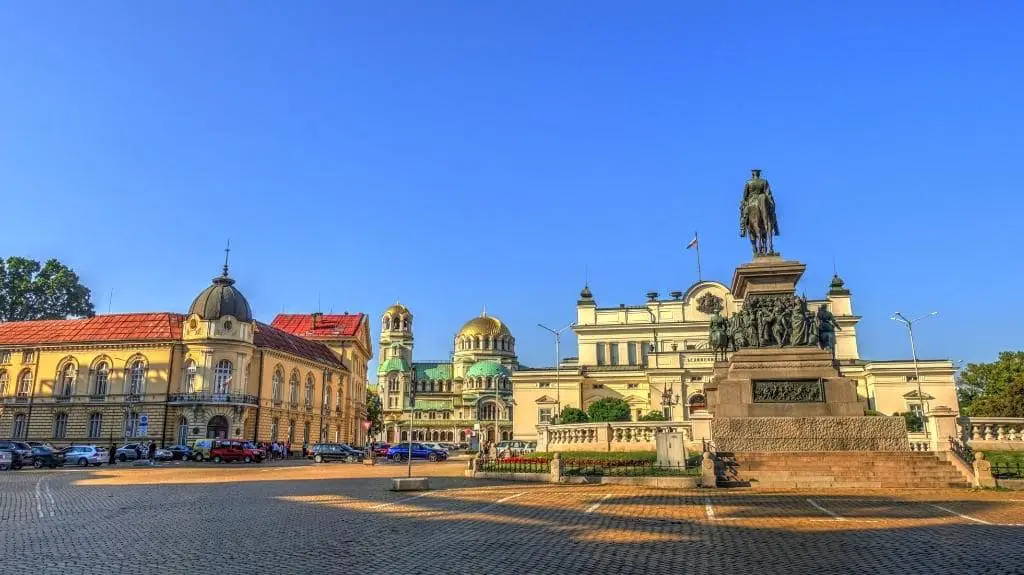
This wraps up our list with 33 amazing things Sofia is known for.
The Bulgarian capital will amaze you with its verdant parks, ancient history, hot mineral springs, opulent religious temples, and peculiar museums.
To make the most of your trip, organize your visit in advance by booking your accommodation here.
Now, we’d love to know:
What springs to mind when you think about Sofia?
Shoot us a comment below.
